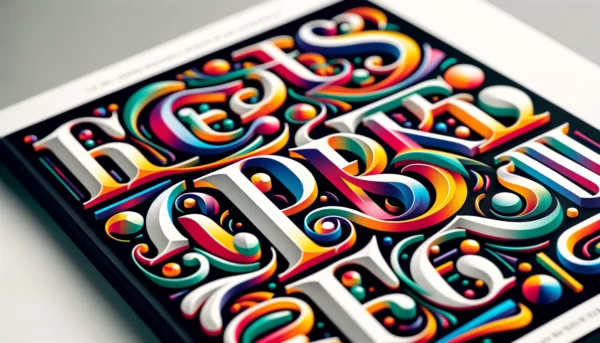They say, “Don’t judge a book by its cover,” but the reality? Nearly 60% of Americans admit to buying a book purely based on its cover, and remarkably, 96% of them felt the story lived up to their expectations.
Your book cover is more than just a protective layer—it’s a silent salesperson working 24/7 to attract readers. In a split second, it signals the genre, tone, and content, helping potential buyers decide whether to pick it up or move on. In a crowded marketplace, a well-designed book cover isn’t just important—it’s essential.
Think about it—when was the last time a book cover stopped you in your tracks? Did it make you curious enough to flip it over and read the summary on the back of the book? That small moment can be the difference between a sale and a missed opportunity.
This article will break down the essential book cover elements that make a book stand out. We’ll explore what makes a good book cover, the key parts of a book cover, and the role of the front and back design. Plus, we’ll look at book cover analysis, expert tips, and tools—like Spines Publishing—that can help you create a cover that not only looks great but also sells.
Book Cover Analysis: Why First Impressions Matter More Than You Think
In the bustling bazaar of books, your cover acts like a lighthouse, guiding readers through a sea of titles to the safe harbor of your story. It’s the initial encounter anyone has with your book, and as we’re all aware, initial perceptions create enduring effects. A well-crafted cover doesn’t just snag the eye—it can dramatically amplify your book’s visibility and market success.
The old saying, ‘First impressions are lasting impressions,’ holds especially true in the literary world.A compelling cover can dramatically elevate a book’s visibility, entice readers, and drive sales. According to a survey by The Book Smugglers, 79% of readers say covers play a decisive role in their decision to purchase a book, emphasizing how critical a cover’s appeal is to sales potential.
How a Book Cover Influences Reader Decisions
Your book’s cover is a narrative in itself. Before a reader turns the first page, your cover’s color scheme, typography, imagery, and layout have already begun to tell a story. These elements are meticulously crafted to align with the book’s content, setting the stage for the reader’s journey. For example, vibrant, whimsical covers might attract those seeking a cheerful or humorous read, whereas darker, more somber designs could draw fans of thrillers and mysteries. A study published by the Association of American Publishers reveals that color influences consumer purchase decisions by 85%, highlighting the significance of choosing the right palette.
Don’t underestimate the power of your book cover. Far from just being a pretty facade, it’s a potent marketing tool that captures attention, embodies your book’s essence, and significantly boosts your sales figures. Investing wisely in cover design is investing in the future success of your book.
Key Elements of a Book Cover
A book cover is much more than just an artistic cover; it’s the primary marketing asset that entices readers to dive into your pages. Here’s a detailed breakdown of the essential elements that construct a compelling book cover, designed to attract attention and provide hints about the book’s content.
Book Title
The title is the centerpiece of your book cover design. It needs to be prominent and easily readable, ensuring it catches the reader’s eye immediately. The choice of font style, size, and color is crucial to make it stand out, especially on digital platforms where covers are often seen first as small thumbnails. Keeping the title clear and concise, as George Orwell suggested with “Never use a long word where a short one will do,” can significantly enhance its impact.
Author Name
Your name should be clearly visible and usually placed either above or below the book title. For well-known authors, the name can be a major draw and is often given prominent display. For emerging authors, ensuring the name is clear and legible is essential for building their brand and recognition among readers.
Imagery (Cover Art)
The imagery or illustrations on the cover reflect the book’s genre, theme, and tone, often serving as the visual hook that attracts readers. This cover art should be high-quality and relevant, effectively setting the stage for the story within and ensuring it resonates with the target audience.
Back Cover Blurb
The blurb on the back cover is crucial as it provides potential readers with a succinct summary of the book’s plot, offering just enough detail to intrigue without giving away key surprises. This blurb should be compelling and well-crafted, as it plays a significant role in converting browsers into buyers.
Spine Design
The spine of the book might seem like a small detail, but it’s incredibly important, especially for physical copies in bookstores. It should include at least the book title and author name in a legible font, designed to catch the eye of someone scanning bookshelves.
Additional Components:
- Reviews and Endorsements: Positive quotes from credible sources can boost the book’s appeal if placed strategically on the cover or the back.
- Author Bio: While often found inside the book, a brief bio on the back cover can help forge a personal connection with potential readers, adding a layer of credibility and interest.
Each of these elements is designed not only to make the book stand out but also to give readers a glimpse of what awaits them inside, enhancing both the book’s appeal and its potential for success.
Designing a Compelling Front Cover: Key Tips & Best Practices
Designing the front cover of a book is a critical step in attracting potential readers and effectively conveying the essence of your story. Here’s a streamlined approach to creating a visually appealing and impactful front cover to attract readers:
Key Features to Include on Your Book’s Front Cover
- Book Title: Ensure the title is the clear focal point, prominently displayed and easily readable at different sizes.
- Author Name: Position the author’s name to ensure visibility, emphasizing it for established authors and ensuring clarity for newcomers.
- Cover Art: Choose imagery that reflects the genre and theme, compellingly drawing readers’ interest.
- Incorporating Reviews: Showcasing positive reviews on your book’s front cover can significantly enhance its appeal. Highlighting accolades or endorsements from respected sources instantly builds credibility and can attract potential readers by signaling that the book is worth their time and investment.
Advanced Design Techniques
- Color Psychology: Leverage color psychology to evoke specific emotions. For example, use red for excitement or blue for calmness, tailoring the palette to the book’s mood and genre.
- Dynamic Typography: Experiment with dynamic typography. Consider how different fonts portray different atmospheres—serif fonts can suggest formality or tradition, while sans-serif fonts might convey a more modern and clean look.
- Layering and Texture: Add depth by using layers or textured backgrounds. These can add a tactile sense even in digital views, making the cover stand out in crowded platforms.
5 Best Practices for Front Cover Design
- Balance and Symmetry: Employ principles of balance and symmetry to create a harmonious and pleasing layout that naturally attracts the eye.
- Contrast for Impact: Use contrast effectively—not just with colors but also with font sizes and image placements—to make key elements like the title and author name pop.
- Focus on Genre Cues: Integrate genre-specific design cues to immediately communicate the type of book to potential readers, such as a mysterious silhouette for thrillers or a soft, pastel landscape for romance.
- Incorporate Negative Space: Smart use of negative space can enhance the cover’s design by focusing attention on the central elements and giving the viewer’s eye a place to rest.
- Iterative Design Process: Engage in an iterative design process. Start with multiple drafts and refine your design based on feedback from a diverse group of readers and other designers to ensure the cover not only looks good but also effectively communicates the book’s core message.
By focusing on these detailed practices and principles, you can craft a front cover that is not only aesthetically pleasing but also strategically aligned with your book marketing goals, ensuring it attracts and resonates with your target audience.
Intro The Cover Design Process
Investing in a professional cover design transcends mere aesthetics; it is a strategic marketing decision that significantly enhances your book’s marketability and credibility. A compelling cover not only grabs attention but also plays a crucial role in the book’s commercial success. According to a report by Cover Matters, books with professionally designed covers see a 34% increase in sales compared to those without. This statistic underscores that a well-crafted cover is not merely decorative—it’s an integral component of a book’s overall marketing strategy, impacting everything from first impressions to long-term sales.
The Cover Design Process: From Concept to Completion
- Concept Development: The journey begins with brainstorming sessions between the designer and author, focusing on aligning the cover with the book’s content, genre, and target audience. This phase includes market research to identify current trends and successful covers in similar genres.
- Design Brief Creation: A comprehensive design brief is developed, detailing the book’s themes, required elements, preferred color schemes, and font choices, which guides the initial design efforts.
- Initial Designs and Mockups: The designer then creates several sketches or digital mockups, offering the author a range of options and ensuring the cover visually embodies the author’s vision.
- Feedback and Iterative Revisions: Feedback from the author on these initial designs leads to iterative revisions, refining the cover to perfectly align with the book’s messaging and aesthetic goals.
- Final Design Approval and Production: After achieving a design that meets the author’s expectations and captures the essence of the book, the final cover design is approved and prepared for both print and digital distribution, adhering to all necessary technical specifications.
A professional cover designer brings a wealth of expertise and insights, ensuring the cover is not only visually stunning but also functionally effective in both physical and digital marketplaces. This investment aids in branding, reduces time and stress for the author, and turns the cover into a powerful marketing tool that attracts the right audience and enhances sales.
The Secret Sauce of Book Marketing – Strategic Cover Design
Think of the cover design process as less of a chore and more of a secret weapon in your publishing arsenal. When an author’s creative vision shakes hands with a designer’s expertise, the result is a book cover that doesn’t just sit pretty on the shelf—it works tirelessly, charming readers and persuading browsers to become buyers. This dynamic duo of creativity and strategy doesn’t just enhance your book’s curb appeal—it turbocharges its market presence and reader engagement. So, invest in professional cover design; it’s not just a cover, it’s your book’s first, and best, sales pitch!
What Is the Summary on the Back of a Book Called? It’s a Book Blurb!
A book blurb, often the unsung hero of book marketing, plays a pivotal role in converting curiosity into sales. This concise and catchy summary is your last pitch to the reader, crucial for tipping the scales from “maybe” to “must read.”
Think of the back cover as your book’s silent salesman. While the front cover stops them in their tracks, the back cover convinces them to make a purchase. It’s where potential readers turn to get the juicy details that decide whether they’ll dive into your world. The back cover blurb is not just a placeholder—it’s a powerful marketing tool that complements the allure of the front.
What Makes a Great Book Blurb? Crafting an Irresistible Synopsis
A good blurb effectively balances intrigue and information, enticing readers with enough detail to pique interest while leaving enough mystery to compel them to read the book. The key elements of a successful blurb include:
- Introduction of Main Characters and Setting: Provide a glimpse into who the main characters are and where the story unfolds, which helps readers quickly connect with the narrative’s central elements.
- Presentation of the Central Conflict: Clearly outline the core problem or challenge faced by the characters without giving away any spoilers. This sets the stage for the narrative drive of the book.
- Evocative Language: Use powerful and emotive language to evoke curiosity and excitement. This language should match the tone and style of the book, whether it’s a thrilling mystery, a heartwarming romance, or a gripping fantasy.
- A Compelling Hook: Start with a strong opening line or question that grabs attention immediately. This could be a provocative statement or a teaser that hints at the story’s depth and complexity.
⚡Example of a great blurb:
“Alicia Berenson was the epitome of success and stability—a renowned painter married to a sought-after fashion photographer, residing in a picturesque London home with views of a lush park. Their perfect life is shattered one fateful evening when Alicia shoots her husband Gabriel five times in the face upon his return from a shoot. The more shocking twist? Following the murder, Alicia seals her lips, trapping her motives in a silent vault. What pushed her to such a violent end? Uncover the silent secrets that lie buried in a seemingly perfect life.”
– The Silent Patient by Alex Michaelides
The Role of the Back Cover
The back cover serves as a crucial bridge between initial curiosity and the decision to purchase, converting casual browsers into committed readers. Here’s how to effectively utilize this space:
Author Bio: More than just a list of achievements, the author bio on the back cover should forge a personal connection with the reader. Highlight relevant aspects of your background or interesting tidbits that relate to the book’s content. For new authors, incorporating a quirky detail or personal anecdote can enhance relatability and memorability.
Reviews and Endorsements: Displaying positive reviews and endorsements prominently on the back cover can significantly sway a reader’s purchasing decision. These accolades serve as social proof, reinforcing the book’s value and quality.
Together, these elements do more than fill space—they enhance the intrigue established by the front cover. By providing substantive insights such as a compelling synopsis, an engaging author bio, and persuasive endorsements, the back cover deepens interest and drives sales. Ultimately, the strategic design of the back cover not only complements the visual appeal of the front but also plays a pivotal role in the book’s market success, demonstrating that often, it’s the back of the book that seals the deal.
Your Publishing Journey Awaits – Start NowGenre-Specific Cover Design: Mastering the Art of Visual Appeal
Imagine navigating the world of book cover design as if you were dressing up for a genre-themed costume party. Each genre has its unique costume, and it’s crucial that your book wears the right one. A thriller might cloak itself in a shroud of darkness with bold, suspenseful lettering, while a romance novel might adorn itself in a flowy gown of pastel hues and elegant fonts that whisper of love and longing. Mastering these visual cues is like learning the secret handshake of each genre’s fan club—it ensures your book catches the eye of those already in love with that type of story.
As each genre has unique expectations for cover design, staying updated with the latest trends is essential. For a closer look at what’s leading the trends across various genres, visit our comprehensive guide here
Importance of Understanding the Target Audience
Knowing your audience is like knowing your dance partner’s favorite song. It’s about understanding what moves them, what themes resonate, and what visual cues make them want to engage. This deep insight helps tailor a book cover that not only stands out on a crowded shelf but also sings in a pitch-perfect tone that is irresistibly attractive to your ideal readers. Market research, reader surveys, and analyzing successful books in your genre are the steps to choreographing this perfect dance.
Examples of Genre-Specific Cover Design Elements:
- Literary Fiction: Envision covers that are canvases of minimalist art—abstract, understated, yet profound. These covers often use muted color palettes and sophisticated typography to mirror the depth and nuance of the narrative.
- Historical Fiction: These covers are time machines, featuring elements like vintage photographs, sepia tones, and elegant serif fonts that transport readers back in time. Each element is carefully chosen to evoke the specific era of the story, enriching the reader’s journey into history.
- Poetry Books: Poetry covers are like whispers in a busy room, standing out through the art of subtlety. They often utilize minimalistic graphics, gentle colors, and plenty of white space, inviting readers into a world of introspective and expressive beauty.
Tailoring your book’s cover to fit its genre and appeal directly to your target audience is not just about aesthetics—it’s a critical marketing strategy. By dialing into the preferences and expectations of potential readers, you craft a visual invitation that’s hard to resist. A well-designed cover acts as a beacon, drawing readers towards your book and, ultimately, into the worlds you’ve created. Remember, in the bustling market of books, the right cover is not just decoration—it’s a key to unlocking your book’s success.
Visual and Graphic Elements
Designing a book cover is like staging a Broadway show; every visual element plays a part in telling a story that captivates the audience before the curtain even rises. Let’s pull back the curtain on how to orchestrate a show-stopping cover:
Color Scheme: The Mood Lighting
Colors are the mood lighting of your cover, setting the emotional tone before a word is read. Warm colors like red and orange ignite excitement and passion, turning the heat up on thrillers, while cool blues and greens paint a picture of calm, perfect for whisking readers away to serene, fantastical worlds. The key is to align your color palette with the book’s genre, enhancing the visual drama that unfolds at first glance.
Typography: The Casting Call
Fonts are the cast of your cover’s show; choose them wisely to evoke the right atmosphere. Bold, sharp fonts might march across a thriller cover, drumming up urgency, while elegant, flowing scripts in a romance novel gently pull the reader into a dance of words. Size, style, and placement are your directorial debut, ensuring the title and author’s name are not only legible but also stars in their own right, even in the crowded thumbnail scene.
Imagery and Illustrations: The Set Design
Just like a set can transport an audience, high-quality images or illustrations set the stage for your story. Historical fiction might don detailed period costumes, while fantasy could dazzle with otherworldly vistas. Choose imagery that hints at the narrative within, making it striking and memorable, much like the pivotal scene of a hit play.
Graphics and Icons: The Special Effects
Icons, borders, and patterns are the special effects of your cover—used sparingly, they enhance without overwhelming. They should complement the main performance, adding depth and intrigue without stealing the spotlight.
Contrasting Colors and Cohesive Look: Ensuring a Standing Ovation
Using contrasting colors effectively spotlights key elements like the title and author’s name, ensuring they catch the eye like a spotlight. A cohesive design ensures all visual elements sing in harmony, creating a professional and polished look that resonates with the audience and leaves them applauding for more.
💡Choosing the Right Visual Elements: Selecting the right visual elements is your strategic directorial choice—it determines whether your book cover will be a blockbuster hit or a box office flop. The visual design should not only hint at the book’s genre, tone, and themes but also make a promise to the reader about the adventure they’re about to embark on. A well-designed cover is a visual promise, a prelude to the story that beckons readers to step into a new world.
By carefully orchestrating these elements, you create more than just a book cover—you craft a visual invitation, a doorway that leads readers into the world you’ve spun from the very first glance.
5 Tips for Great Book Cover Design
1. Simplicity is Key: Aim for a clean and uncluttered design. Too many elements can overwhelm potential readers. Focus on a few strong visual components that clearly convey the book’s message and genre.
2. Prioritize Readability: Ensure that the title and author name are easily readable, even in thumbnail size. Choose fonts that are clear and appropriate for the book’s genre. Avoid overly elaborate fonts that can be difficult to read.
3. Use High-Quality Images: Whether you opt for illustrations, photographs, or abstract art, make sure the images are high-resolution and professionally rendered. Poor-quality images can make the entire cover look amateurish.
4. Choose the Right Colors: Colors should be chosen based on the book’s genre and the emotions you want to evoke. Use contrasting colors to make the text stand out and ensure readability.
5. Reflect the Genre: Your cover should immediately signal the book’s genre to potential readers. Use visual cues common to your genre to set the right expectations. For example, dark tones and sharp fonts for thrillers, or pastel colors and elegant fonts for romance.
The Importance of a Clear Idea and Single Message
A successful book cover should communicate a single, clear idea. Avoid trying to include too many concepts or visual elements. Instead, focus on one central theme or image that encapsulates the essence of your book. This clarity helps attract readers by making the cover’s message immediately understandable and compelling.
Research and Inspiration
Research is invaluable in the book cover design process. Spend time looking at bestselling books in your genre to understand what works. Analyze covers by famous authors and note the design elements that make them stand out. Online resources like design blogs, Pinterest, and book cover galleries can provide inspiration and keep you updated on current trends.
By following these tips, indie authors and publishers can create a professional and appealing book cover. Investing time in design research and focusing on clarity will help ensure your cover attracts the right readers and effectively represents your book.
Striking the Perfect Balance: Aesthetic Appeal Meets Strategic Marketing
Creating a book cover is like crafting a billboard for your book, especially if you are self-publishing a book. Most self-publishing companies offer self-publishing services to help you strike the perfect balance. It has to be visually striking to catch the eye and strategically crafted to communicate the book’s essence. Achieving this balance means blending beauty with purpose, ensuring every design element not only captivates but also conveys the genre, tone, and core message, effectively attracting the right audience.
Building the Author Brand and Capturing the Ideal Reader
A book cover is a cornerstone in building an author’s brand. It’s the first handshake with the reader, where visual consistency across titles can foster recognition and trust. For emerging authors, the cover is a prime opportunity to showcase professionalism and uniqueness, setting the tone for the reader’s journey. It should mirror the author’s style and the narrative’s voice, forging a strong, memorable brand identity.
The cover also plays a crucial role in seducing the ideal reader. This requires a deep understanding of the target demographic’s likes and expectations. For instance, young adult covers might burst with vibrant, bold designs, while adult fiction might lean towards sophisticated and subtle aesthetics. Choosing the right typography, imagery, and color scheme is key to resonating with the intended audience.
Aligning Design with Genre and Tone
Effective cover design requires a keen alignment with the book’s genre and tone. This alignment informs reader expectations and guides their choice. A thriller might cloak itself in dark hues and bold typography to suggest suspense, while a romance could wear soft colors and elegant fonts to whisper of love. The cover should reflect the book’s mood, whether it’s light-hearted, serious, or mysterious, ensuring it accurately represents the story within.
In conclusion, a successful book cover does more than stand out—it speaks to the reader. It’s a critical tool in marketing, capable of establishing a brand, enticing the ideal reader, and aligning with the book’s thematic elements. By thoughtfully balancing aesthetic allure with marketing savvy, authors and designers can craft covers that are not only visually impressive but also powerful catalysts for book sales.
The Art of the Cover: Your Story’s First Handshake
Diving into the nuances of book cover design reveals its undeniable impact—from grabbing attention with the front cover to sealing the deal on the back. Effective cover design is your book’s first interaction with potential readers, setting the stage for what lies within its pages.
In today’s competitive market, a well-crafted cover is more than an aesthetic choice; it’s a strategic necessity. Leveraging tools like Spines can transform this challenge into an opportunity, ensuring your book not only looks appealing but also captures the essence of your narrative.
Invest wisely in your cover design—it’s the handshake that turns browsing into buying, inviting readers to turn the page on a new adventure.
FAQs – Book Cover Elements
Q: What are the key elements of book cover design?
The key elements include the book title, author name, imagery, and typography that collectively convey the book’s genre and tone. These components must be harmoniously balanced to create a visually appealing and immediately recognizable cover that attracts potential readers.
Q: How do color psychology and typography influence book sales?
Color psychology and typography significantly impact how a book is perceived; colors evoke emotions while typography can set the tone or suggest the genre. For example, bright colors might attract younger readers, while elegant fonts can appeal to those interested in literary fiction, influencing purchasing decisions based on visual appeal.
Q: What makes a book cover stand out in a digital marketplace?
In a digital marketplace, a book cover needs to be visually striking and clear even at thumbnail size. Key elements like a legible title and an eye-catching image play crucial roles in making a cover stand out, thereby increasing its chances of being clicked and potentially purchased.
Q: How can authors effectively use the back cover to enhance book sales?
Authors can use the back cover to include a compelling blurb, key reviews, and a brief author biography to build credibility and intrigue. These elements should succinctly convey the essence of the book and persuade readers that this is a story worth investing in.
Q: What should be included on the spine of the book?
The spine of the book should at least include the book’s title and the author’s name in a clear, legible font. This ensures that the book can be easily identified and pulled off a shelf in a bookstore or library, especially when only the spine is visible.
Q: How do I choose the right imagery for my book cover?
Choosing the right imagery involves selecting visuals that accurately represent the book’s content and appeal to the book’s target audience. The imagery should align with the genre’s conventions and the book’s mood, whether it’s an adventurous scene for a fantasy novel or a subtle, thematic illustration for literary fiction.
Q: Can the design of a book cover affect reader expectations and satisfaction?
Yes, the design of a book cover sets initial expectations about the content and style of the book. If the cover accurately reflects the narrative, it can lead to greater reader satisfaction. However, a misleading cover may set incorrect expectations, potentially resulting in disappointment and affecting the overall reception of the book.







